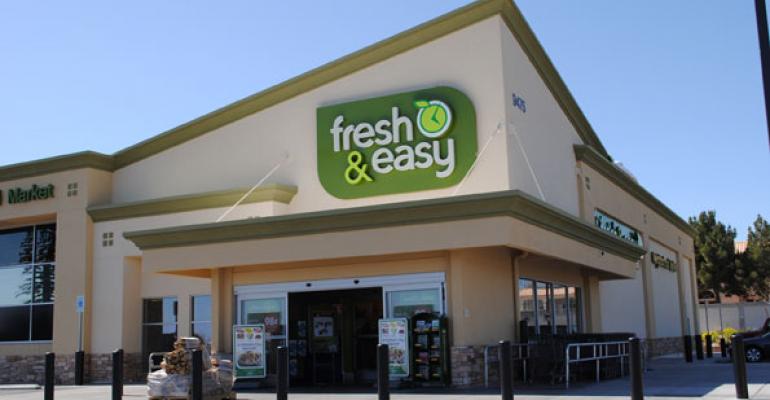 EL SEGUNDO, Calif. — Fresh & Easy Neighborhood Market here has received a vote of confidence from the top executive at Tesco, its British-based parent company.
EL SEGUNDO, Calif. — Fresh & Easy Neighborhood Market here has received a vote of confidence from the top executive at Tesco, its British-based parent company.
The decision to stick with the U.S. business came a few days after one of Tesco’s largest shareholders said the company needed to “think long and hard” about focusing on its British operations rather than “other areas of the business, such as America.”
Despite pushing back by a year the timeframe for reaching a break-even point and slowing the rate of expansion this year, Philip Clarke (pictured), Tesco’s chairman and chief executive officer, said there are no plans to pull the plug on its U.S. venture.
“Fresh & Easy is a business for us all to be proud of now,” he said in comments released by Tesco. “It has moved from increasing losses to reduced losses — a real turning point for the business.
“It does a great job for customers, and I confidently expect it to get through to break-even and then to be able to demonstrate it can make sustainable, positive returns for shareholders.”
David Gray, a retail analyst for Planet Retail, London, told SN he expects Tesco to “stick it out” with Fresh & Easy “because it stands to lose too much if it exits — and the potential in the U.S. market is so large.
“To pull out now would leave it with more than $700 million in losses and a lot of capital investment, though it would presumably get back some capital from selling the stores.”
Related story: Fresh & Easy in Crosshairs of Investors
According to Gray, the key issue for Fresh & Easy is the rate of store expansion.
“It built the distribution center in Riverside, Calif., to service 300 stores, but with just 185 stores at the end of the fiscal year and only 45 more scheduled to open this year, the facility will still be operating short of capacity.
“But even if Fresh & Easy doesn’t reach break-even by February of 2014, Tesco is generating profits close to $4 billion overall, so in the grand scheme of things, the U.S. losses are relatively small compared with the size of the entire group.
“And those losses are coming down, so it will reach break-even — it’s just a question of opening enough stores to operate the distribution center at full capacity.”
A contributing factor to Fresh & Easy’s challenges in dealing with American consumers, Gray pointed out, is that Tesco cannot gain consumer insights from its partnership with Dunnhumby, as it does in the United Kingdom, because Kroger Co., Cincinnati, has exclusive rights to work with Dunnhumby in the U.S.
Nick Everitt, director of retail insight for IGD, London, also expressed a positive outlook for Tesco’s U.S. stores.
“Tesco clearly sees significant potential in Fresh & Easy, [with] several encouraging signs of improvement,” despite not yet breaking even,” he told SN.
“Like-for-like sales are up, and more stores are becoming profitable, indicating a positive return on Tesco’s investment in new ranges and categories such as bakery and produce.
“One of the reasons Clarke has extended the timing of the initial break-even period is to allow more time to increase store profitability and deal with the slowdown in store expansion.”
SN's 2012 Top 75 Fresh & Easy Page
Jim Hertel, managing partner at Willard Bishop, Barrington, Ill., said the announcement that the break-even point would be delayed by a year “was probably a prudent thing for Tesco to do, as was deciding to slow the rollout of new stores.
“And given what I’ve read about Tesco investors being grumpy about the money already invested in Fresh & Easy, whether or not it has a long-term future may have less to do with actual performance and more to do with investor impatience.”
For the year, which ended Feb. 28, the loss at Fresh & Easy was $245 million (U.S.), compared with $303.6 million a year ago. Sales for the year rose 26.3% to $1.02 billion, and like-store sales increased 11.9%. The company did not release separate financial results for the second half, though it said like-store sales rose 12.1%; based on first-half results, the loss for the second half was $80 million, with sales of $551.3 million.
Tesco said it expects Fresh & Easy to reach break-even in early 2014 rather than early 2013, as it had previously predicted.
“The business is on track to deliver a further significant reduction in losses during the current year,” the company said. “This is because we intend to focus on delivering store-level profitability first before pushing on faster with the expansion we need to create sufficient scale to cover our overheads.
“We ended [the fiscal year] with 185 [Fresh & Easy] stores, and this revised development program will take us to [approximately] 230 stores by February 2013, consistent with our more conservative approach to new capital commitment across the [Tesco] group.
“Fresh & Easy has made encouraging progress against its demanding improvement plan. It reduced losses for the first time [since it was founded in late 2007], delivering a reduction of 17.7% against last year, and delivered a sustained improvement in like-for-like sales throughout the year, even against very demanding comparatives and despite absorbing the implementation costs of the ‘friends’ loyalty program in the second half.
“This performance was driven by further improvements in the offer for customers as we extend the changes we have made at some stores to more of the estate. As a result, we are more confident about the outlook for the business, although clearly much remains to be done.
“Our first clear objective was to accelerate the already strong growth in customer numbers, and this is being met. The further changes we have been rolling out to the stores as we adapt the offer better to the needs of local customers have been very well received, including introducing in-store bakeries, loose produce, additional ranges in grocery [and] many new Fresh & Easy products. The impact of these improvements can also be seen in the performance of new stores.”

